We began DBO-5 yesterday offshore from Barrow, AK also known as Barrow Canyon. As we finished this line, I took some pictures of the biodiversity that we have seen here. Stay tuned for DBO-5 organisms in a future blog! I have also included the expedition plan below to show the DBO-5 sampling line and the path we have taken so far.
 DBO Station Sampling Map for the Healy 2019 Expedition.
DBO Station Sampling Map for the Healy 2019 Expedition.
Today, I would like to talk about some very charismatic creatures that we have seen while traveling just south of Bering Strait. The Orca Whale! Although the name implies that they are a species of whale, they are actual members of the Delphinidae family of oceanic dolphins. They can be up to 32 feet long, live from 30-90 years, and can be found in all of the world's oceans. Orcas travel in pods of a few individuals up to a pod of 20. When we saw Orcas from the Healy, they were in pods of 5-7.
 Orca whales from the Healy (Courtesy of Lindsey Leigh Graham)
Orca whales from the Healy (Courtesy of Lindsey Leigh Graham)
Orca Whales are particularly interesting because they categorized by ecotype. Orcas are found in all oceans and so their food source changes depending on where they live. Ecotypes of the Orca are defined by where they live and what they eat. Since there is some overlap between ecotypes here in the Arctic and we did not have an Orca expert on board, we could not determine which group the individuals belonged to.
 Two Orcas from the Healy (Courtesy of Lindsey Leigh Graham)
Two Orcas from the Healy (Courtesy of Lindsey Leigh Graham)
Pods of Orcas often hunt together and communicate through clicks and whistles underwater. The behaviors that they exhibit are learned throughout their life. Juvenile Orcas mimic the adults in their pod in order to acquire skills such as hunting and socializing. Orcas are very intelligent animals and it was amazing to see them in the wild. Thank you (once again) to Lindsey Leigh Graham for taking some amazing photos!
A Question From the Crow's Nest
How did the the Orca get the name "Killer Whale"?
Answer from previous post: Specific survival times in the Arctic Ocean depend on the water temperature, but on average, no gumby suit will result in hypothermia in 15 minutes and death in 25 minutes. With a gumby suit, you can survive about 20 hours.


Comments
Add new comment